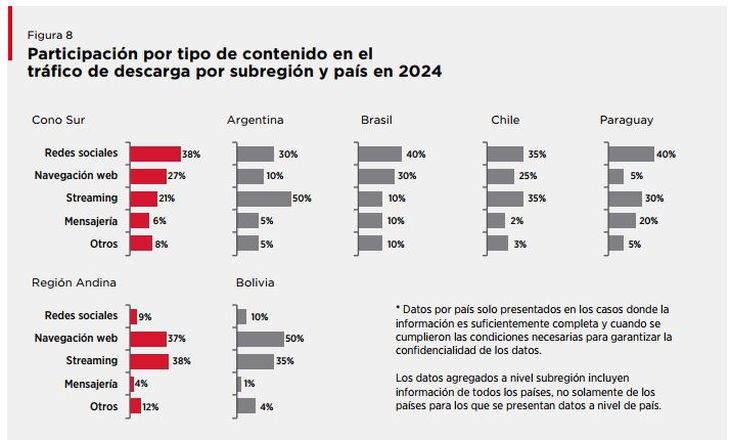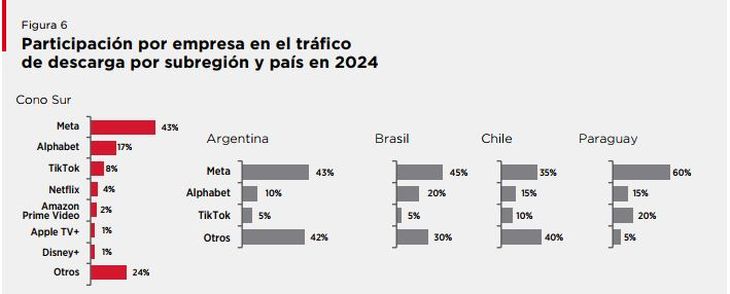But the discussion over the almost monopolistic use of networks points in another direction. “Seeing 70% of mobile traffic concentrated in three companiesone might think that it is a mere reflection of the users’ choice. But the truth is that a considerable portion of that traffic is unsolicitedsuch as the advertisements that we see when opening our applications, or videos in resolutions much higher than those we can see on the device,” said Lucas Gallitto, director for Latin America at GSMA.
GSMA (Global System for Mobile Communications Association) is the entity that brings together the 750 largest mobile operators in the world. In addition, it represents 400 companies from this entire ecosystem such as manufacturers of mobile phones and portable devices, software companies, equipment suppliers and Internet companies, and organizations from sectors linked to the industry.
Therefore, every sentence that appears in your reports not included by chancebut echoes the interests of the powerful companies in the sector, such as AT&T, China Mobile, Deutsche Telekom, Liberty Global, Orange, Swisscom, Telenor, Telstra, TIM, Verizon and Vodafone, among others. By Argentina Telecom Personal, Telefónica Movistar and Claro (América Móvil) participate.
INFOGRAPHIC CONNECTIVITY BY COUNTRY.JPG
“Today the platforms They do not pay costs for that traffic that they monetizeand what has a negative impact on user experience, network capacity and the environment. From here arises the need for fair share: a market mechanism by which the large traffic generators contribute to the financing of networks to encourage more efficient use of this resource for everyone,” he added.
Meta led the generation of download traffic on mobile networks, concentrating around 50% in 2024 and almost tripling the traffic generated by the second provider (Alphabet). This situation has remained relatively stable from 2022 to the present.
He also highlights that in recent years the growth of TikTok and the percentage increase in traffic concentration by Meta have been fundamentally highlighted.
On the other hand, streaming and audio on-demand platforms presented concentrations of traffic that are below 5% in 2024.
A common denominator of the traffic generated by the three platforms is the intensive use of videoin short or long format. And this worries mobile network operators, since they anticipate that the data demand for this content will continue to increase with the increase in resolutions (from HD to 4K, and eventually 8K) and the expansion of live-streamed events.
BY TYPE OF DOWNLOAD EACH COUNTRY.JPG

Audiovisual content is one of the main drivers of the sustained growth of mobile traffic, which multiplied 14 times between 2016 and 2023.
Only the annual growth in 2023 was greater than the total traffic volume in the region five years earlier, in 2018. By 2030, annual traffic is expected to grow by 22 exabytes (22 billion gigabytes) compared to the previous year, almost double the annual growth recorded in 2023, which was 12 exabytes. “This increase will put even more pressure on the capacity of mobile networks”warns the GSMA report.
In this sense, the report highlights that at the end of 2023 there were 418 million people in Latin America (65% of the population) who used mobile internet, which represents an increase of 75 million in the last five years.
“While changes have been very rapid in recent years, progress from now on will be increasingly complex. Some countries They are already about to reach their connectivity limit in current market conditions, which imposes the need to implement reforms to take full advantage of the potential of mobile technology,” he explains.
“The economic contribution of mobile connectivity highlights the need for stakeholders to take the right steps to maintain the impact of mobile services in the digital economy”he then states when alluding to the commitment that large platforms should assume.
In 2023, mobile technologies and services generated 8% of Latin America’s GDP, a contribution that amounted to US$520,000 million of added economic value. The region’s mobile ecosystem also generated nearly 2 million jobs, between direct and indirect.
Meta is the great generator of mobile traffic in the region
In the last three years (2022-2024), download traffic on mobile networks is much higher than upload traffic at an aggregate level in Latin America, concentrating more than 90% of the total.
“It is therefore the detailed analysis of the origin of download traffic that is of greatest interest to better understand the causes and bottlenecks in terms of capacity in mobile networks,” they explain.
PARTICIPATION BY COMPANY IN CONO SUR.JPG

Also regarding download traffic concentrations in 2024, in all subregions, they were led by Meta, Alphabet and TikTok. Between the three, they concentrate from 68% in the Southern Cone, to 70% in the Andean Region and up to 75% in the Central American region and Mexico.
Meta concentrated from 40% of download traffic in the Southern Cone to more than 55% in the region of Central America and Mexico, doubling or tripling the value of the second option (Alphabet) depending on the case.
Goal is the largest traffic generator in most of the countries analyzed. Alphabet, for its part, is the second largest traffic generator in some of the most relevant markets in the region.
However, since 2022 TikTok has been increasing its participationbecoming the second largest traffic generator in countries such as Paraguay, Bolivia and Nicaragua; and even positioning itself as the largest generator of download traffic in Honduras.
The report also examines mobile traffic by type of use, with social networks (41%), web browsing (29%) and streaming (19%) leading the way. This podium repeats throughout the region with some variations.
In the Southern Cone, the use of social networks is predominant. But there are also cases like Argentina, Chile and Paraguay where streaming It is positioned among the first two main uses of mobile networks.
In the Andean Region, web browsing and streaming are the main sources of use of mobile network capacity, representing almost 75% of traffic. As in the previous section, the opening by country is only presented in the case of Bolivia, since it was the only country where the necessary conditions to guarantee the confidentiality of the data were met.
In Central America and Mexico, social networks are positioned as the main consumption driver, representing close to 60% of download traffic. The exception of Nicaragua stands out with a greater participation of streaming in second place.
Source: Ambito
David William is a talented author who has made a name for himself in the world of writing. He is a professional author who writes on a wide range of topics, from general interest to opinion news. David is currently working as a writer at 24 hours worlds where he brings his unique perspective and in-depth research to his articles, making them both informative and engaging.




